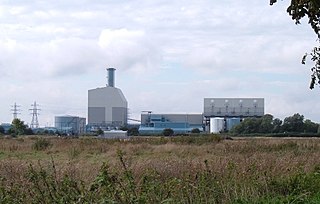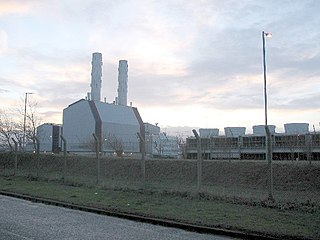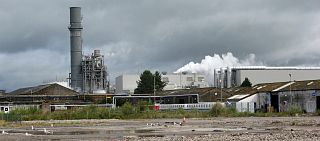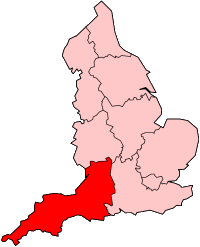
Ballylumford power station "C" station is a natural-gas-fired power station in County Antrim, Northern Ireland, UK. With its main plant generating almost 700 megawatts of electricity, it is Northern Ireland's largest power station and provides half its power. Overall the station can produce 693 MW. The plant is located at the tip of the Islandmagee peninsula, which separates Larne Lough from the Irish Sea. The lough is a Site of Special Scientific Interest. The 3 chimneys of the now decommissioned "B" station are 126 metres tall. East of the station is the Ballycronan More converter station, the Northern Ireland end of the Moyle Interconnector, a subsea HVDC interconnector connecting the NI electricity system to Great Britain.

Rye House Power Station is a 715 MW combined cycle gas turbine (CCGT) power station located near Rye House railway station in Hoddesdon, Hertfordshire.

Teesside Power Station is a former gas-fired power station, in Redcar & Cleveland, England. Situated near the Wilton chemical complex, the station had combined cycle gas turbines (CCGTs) and open cycle gas turbines (OCGTs), however in 2011 the operation of the CCGT part of the station was suspended, and in 2013 the owners announced its closure and plans to demolish it. Prior to the suspension, the station had a generating capacity of 1875 megawatts (MW), making it the largest of any CCGT power station in Europe. The station could meet almost 3% of the electricity demand for England, Wales and Scotland. Opened in 1993, the station was initially operated by Enron but moved into the hands of PX Ltd after the Enron scandal of 2001, before being bought by Gaz de France and Suez in 2008. The station also worked as a cogeneration plant, providing steam for the Wilton complex.

Damhead Creek power station is a 792 MWe gas-fired power station in Kent, England, on the Hoo Peninsula, It is near the site of the decommissioned Kingsnorth power station. The plant entered service in February 2001.

Grain Power Station is a 1,275 megawatts (1,710,000 hp) operational CCGT power station in Kent, England, owned by Uniper. It was also the name of an oil-fired, now demolished, 1,320MW power station in operation from 1979 to 2012.

King's Lynn Power Station refers to a combined cycle natural gas power station near King's Lynn in Norfolk, commissioned in 1997, and now owned by RWE, and to a coal fired power in King's Lynn in operation from 1899 to 1960. The CCGT station was mothballed on 1 April 2012. It can generate 325 MW of electricity and employed 40 people. The site was reopened on 19 November 2019.

Spalding Power Station is a 860 MW gas-fired power station one mile north of Spalding on West Marsh Road close to the River Welland. The current site provides enough electricity for one million households.

South Humber Bank Power Station is a 1,365 MW gas-fired power station on South Marsh Road at Stallingborough in North East Lincolnshire north of Healing and the A180 near the South Marsh Road Industrial Estate. It is around two miles east of Immingham, and employs 64 people. The site of SHBPS is around 500 metres by 400 metres in area. It is next door to the Synthomer plant.

Peterborough Power Station is a 360MW gas-fired power station at Eastern Industry, Fengate in the city of Peterborough, Cambridgeshire in the United Kingdom. It employs around forty people.

Little Barford Power Station is a gas-fired power station just north of the village of Little Barford in Bedfordshire, England. It lies just south of the A428 St Neots bypass and east of the Wyboston Leisure Park. The River Great Ouse runs alongside. It was formerly the site of two coal-fired power stations, now demolished. The station is operated by RWE.

Coryton Power Station is a 732 MW Combined Cycle Gas Turbine (CCGT) gas-fired power station at Coryton, Thurrock, Essex, UK.

Roosecote Power Station was a gas-fired, originally coal-fired power station, situated in the Roosecote district of Barrow-in-Furness in Cumbria, North West England. The gas-fired station opened in 1991 and was the first CCGT power station to supply electricity to the United Kingdom's National Grid, but was mothballed in 2012 after a proposed biomass power station was cancelled. It was situated directly adjacent to Rampside Gas Terminal. The plant was demolished between 2014 and 2015. The site is now a 49 MW battery storage facility.

Deeside Power Station is a power station on the Deeside Industrial Park to the north of Connah's Quay in Flintshire, Wales. Constructed as a 498 MWe combined-cycle gas plant, it is now used to provide inertial response and reactive power services to the grid.

Connah's Quay Power Station is the name of the current 1,420 MW gas-fired power station near Connah's Quay in Flintshire in North Wales. The power plant, which is situated on the south bank of the River Dee, is the modern successor to a coal-fired power station which closed in 1984 and demolished in 1992. The replacement gas-powered plant was completed in 1996 and began producing electricity a year later. It originally received its gas from the Point of Ayr terminal, which in turn comes from the offshore gas fields in Liverpool Bay.

Staythorpe C Power Station is a 1,735 MWe gas-fired power station at Staythorpe between Southwell and Newark-on-Trent in Nottinghamshire, England, between the River Trent and Nottingham to Lincoln railway line. The station was handed over to the owner RWE from Alstom Power with full commercial operation being achieved in December 2010. The official opening ceremony attended by Charles Hendry, Minister of State took place on 9 May 2011.

Pembroke Power Station is a 2,200 MWe natural gas-fired power station near Pembroke in Wales. The power station was officially opened in September 2012 and is the largest gas-fired power station in Europe. It is also the largest power station to be built in the UK since Drax power station came online in 1986. Pembroke Power Station currently generates enough power to supply 3.5 million homes and businesses. It is operated by RWE.

Barry Power Station was a 230 MWe gas-fired power station on Sully Moors Road in Sully in the Vale of Glamorgan, Wales. It was eight miles west of Cardiff and was situated next to a large Ineos Vinyls chemicals works that makes PVC and a Hexion Chemicals plant.

The Dash for Gas was the 1990s shift by the newly privatized companies in the electricity sector of the United Kingdom towards generation of electricity using natural gas. Gas consumption peaked in 2001 and has been in decline since 2010.

Aghada power station is a gas-fired power station located near the entrance of Cork Harbour in Aghada, County Cork. It was built at this location in order to use gas that had been discovered at the nearby Kinsale Head gas field, from which gas was extracted from 1978 until its depletion in 2020.
Blackburn power stations are a series of electricity generating stations that have provided electric power to the town of Blackburn and the wider area from 1895 to the present. The first station in Jubilee Street, Blackburn began operating in 1895. A new larger station known as Blackburn East or Whitebirk power station was commissioned in 1921 and was rebuilt in stages over the period 1942 to 1955. Whitebirk station closed in 1976. The 60 MW Blackburn Mill Combined Cycle Gas Turbine (CCGT) power station has generated electricity since 2002. The Blackburn energy from waste (EfW) plant is currently (2020) being planned.





















